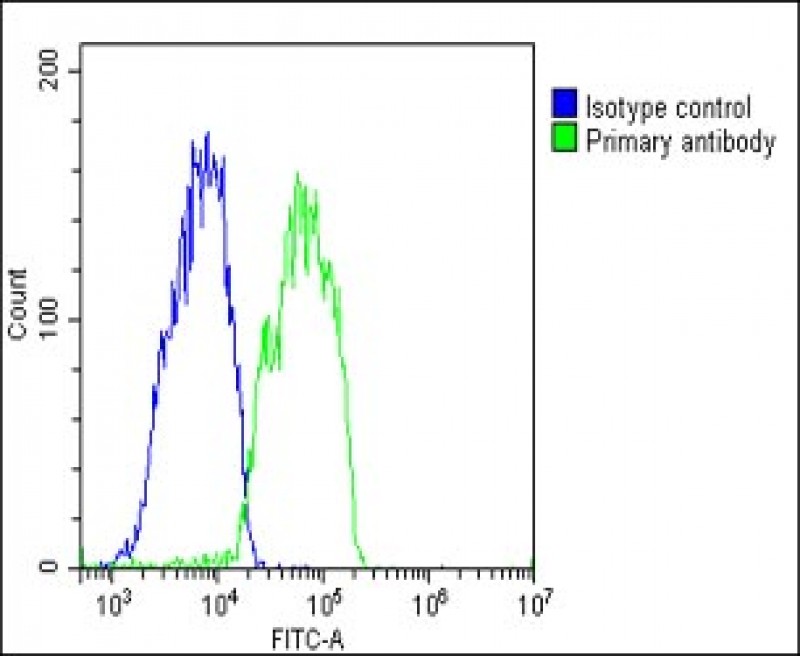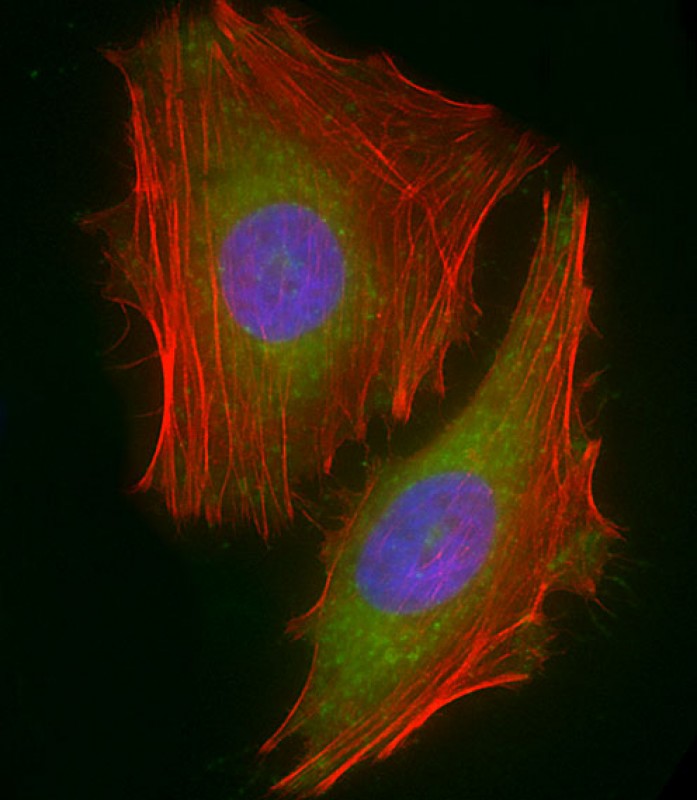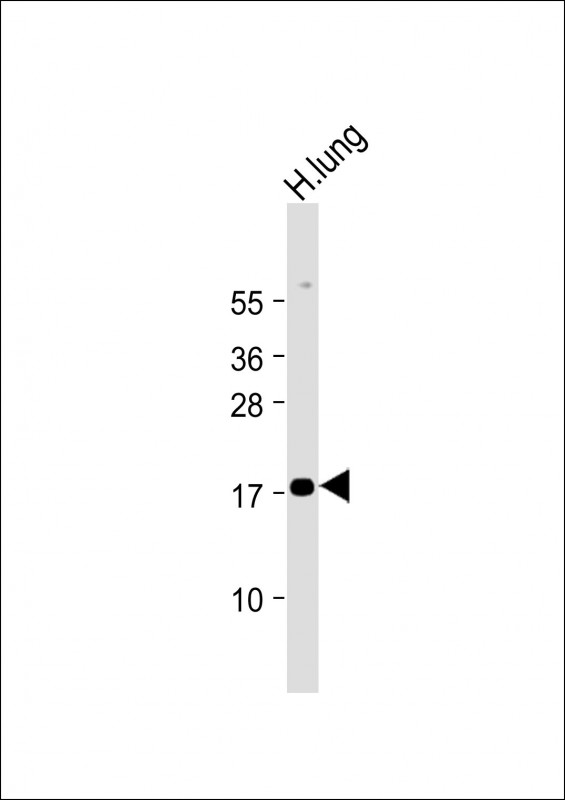RARRES2 Antibody (N-Term)
Purified Rabbit Polyclonal Antibody (Pab)
- 产品详情
- 实验流程
- 背景知识
Application
| WB, IF, FC, E |
|---|---|
| Primary Accession | Q99969 |
| Other Accession | Q5R551 |
| Reactivity | Human, Mouse |
| Host | Rabbit |
| Clonality | polyclonal |
| Isotype | Rabbit IgG |
| Calculated MW | 18618 Da |
| Gene ID | 5919 |
|---|---|
| Other Names | Retinoic acid receptor responder protein 2, Chemerin, RAR-responsive protein TIG2, Tazarotene-induced gene 2 protein, RARRES2, TIG2 |
| Target/Specificity | This RARRES2 antibody is generated from a rabbit immunized with a KLH conjugated synthetic peptide between 01-35 amino acids from human RARRES2. |
| Dilution | WB~~1:2000 IF~~1:25 FC~~1:25 E~~Use at an assay dependent concentration. |
| Format | Purified polyclonal antibody supplied in PBS with 0.09% (W/V) sodium azide. This antibody is purified through a protein A column, followed by peptide affinity purification. |
| Storage | Maintain refrigerated at 2-8°C for up to 2 weeks. For long term storage store at -20°C in small aliquots to prevent freeze-thaw cycles. |
| Precautions | RARRES2 Antibody (N-Term) is for research use only and not for use in diagnostic or therapeutic procedures. |
| Name | RARRES2 |
|---|---|
| Synonyms | TIG2 |
| Function | Adipocyte-secreted protein (adipokine) that regulates adipogenesis, metabolism and inflammation through activation of the chemokine-like receptor 1 (CMKLR1). Also acts as a ligand for CMKLR2. Can also bind to C-C chemokine receptor-like 2 (CCRL2), but with a lower affinity than it does to CMKLR1 or CMKLR2 (PubMed:27716822). Positively regulates adipocyte differentiation, modulates the expression of adipocyte genes involved in lipid and glucose metabolism and might play a role in angiogenesis, a process essential for the expansion of white adipose tissue. Also acts as a pro-inflammatory adipokine, causing an increase in secretion of pro-inflammatory and prodiabetic adipokines, which further impair adipose tissue metabolic function and have negative systemic effects including impaired insulin sensitivity, altered glucose and lipid metabolism, and a decrease in vascular function in other tissues. Can have both pro- and anti- inflammatory properties depending on the modality of enzymatic cleavage by different classes of proteases. Acts as a chemotactic factor for leukocyte populations expressing CMKLR1, particularly immature plasmacytoid dendritic cells, but also immature myeloid DCs, macrophages and natural killer cells. Exerts an anti-inflammatory role by preventing TNF/TNFA-induced VCAM1 expression and monocytes adhesion in vascular endothelial cells. The effect is mediated via inhibiting activation of NF-kappa-B and CRK/p38 through stimulation of AKT1/NOS3 signaling and nitric oxide production. Its dual role in inflammation and metabolism might provide a link between chronic inflammation and obesity, as well as obesity-related disorders such as type 2 diabetes and cardiovascular disease. Exhibits an antimicrobial function in the skin. |
| Cellular Location | Secreted {ECO:0000250|UniProtKB:Q9DD06}. |
| Tissue Location | Expressed at the highest levels in placenta, liver, and white adipose tissue (WAT), and to a lesser extent in many other tissues such as lung, brown adipose tissue, heart, ovary, kidney, skeletal muscle and pancreas. Within WAT, expression is enriched in adipocytes as compared to the stromal vascular fraction. Expression and secretion increases dramatically with adipogenesis. Highly expressed in skin (basal and suprabasal layers of the epidermis, hair follicles and endothelial cells). Expression is elevated in numerous metabolic and inflammatory diseases including psoriasis, obesity, type 2 diabetes, metabolic syndrome and cardiovascular disease |
For Research Use Only. Not For Use In Diagnostic Procedures.
Provided below are standard protocols that you may find useful for product applications.
BACKGROUND
Adipocyte-secreted protein (adipokine) that regulates adipogenesis, metabolism and inflammation through activation of the chemokine-like receptor 1 (CMKLR1). Its other ligands include G protein-coupled receptor 1 (GPR1) and chemokine receptor-like 2 (CCRL2). Positively regulates adipocyte differentiation, modulates the expression of adipocyte genes involved in lipid and glucose metabolism and might play a role in angiogenesis, a process essential for the expansion of white adipose tissue. Also acts as a proinflammatory adipokine, causing an increase in secretion of proinflammatory and prodiabetic adipokines, which further impair adipose tissue metabolic function and have negative systemic effects including impaired insulin sensitivity, altered glucose and lipid metabolism, and a decrease in vascular function in other tissues. Can have both pro- and anti-inflammatory properties depending on the modality of enzymatic cleavage by different classes of proteases. Acts as a chemotactic factor for leukocyte populations expressing CMKLR1, particularly immature plasmacytoid dendritic cells, but also immature myeloid DCs, macrophages and natural killer cells. Exerts an anti-inflammatory role by preventing TNF/TNFA-induced VCAM1 expression and monocytes adhesion in vascular endothelial cells. The effect is mediated via inhibiting activation of NF-kappa-B and CRK/p38 through stimulation of AKT1/NOS3 signaling and nitric oxide production. Its dual role in inflammation and metabolism might provide a link between chronic inflammation and obesity, as well as obesity- related disorders such as type 2 diabetes and cardiovascular disease. Exhibits an antimicrobial function in the skin.
REFERENCES
Nagpal S.,et al.J. Invest. Dermatol. 109:91-95(1997).
Yokoyama-Kobayashi M.,et al.Gene 228:161-167(1999).
Ota T.,et al.Nat. Genet. 36:40-45(2004).
Ebert L.,et al.Submitted (JUN-2004) to the EMBL/GenBank/DDBJ databases.
Hillier L.W.,et al.Nature 424:157-164(2003).
终于等到您。ABCEPTA(百远生物)抗体产品。
点击下方“我要评价 ”按钮提交您的反馈信息,您的反馈和评价是我们最宝贵的财富之一,
我们将在1-3个工作日内处理您的反馈信息。
如有疑问,联系:0512-88856768 tech-china@abcepta.com.























 癌症的基本特征包括细胞增殖、血管生成、迁移、凋亡逃避机制和细胞永生等。找到癌症发生过程中这些通路的关键标记物和对应的抗体用于检测至关重要。
癌症的基本特征包括细胞增殖、血管生成、迁移、凋亡逃避机制和细胞永生等。找到癌症发生过程中这些通路的关键标记物和对应的抗体用于检测至关重要。 为您推荐一个泛素化位点预测神器——泛素化分析工具,可以为您的蛋白的泛素化位点作出预测和评分。
为您推荐一个泛素化位点预测神器——泛素化分析工具,可以为您的蛋白的泛素化位点作出预测和评分。 细胞自噬受体图形绘图工具为你的蛋白的细胞受体结合位点作出预测和评分,识别结合到自噬通路中的蛋白是非常重要的,便于让我们理解自噬在正常生理、病理过程中的作用,如发育、细胞分化、神经退化性疾病、压力条件下、感染和癌症。
细胞自噬受体图形绘图工具为你的蛋白的细胞受体结合位点作出预测和评分,识别结合到自噬通路中的蛋白是非常重要的,便于让我们理解自噬在正常生理、病理过程中的作用,如发育、细胞分化、神经退化性疾病、压力条件下、感染和癌症。








